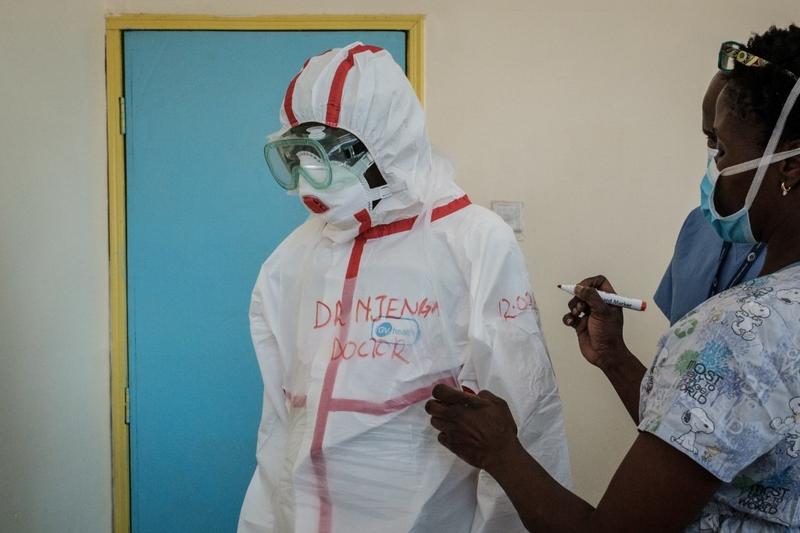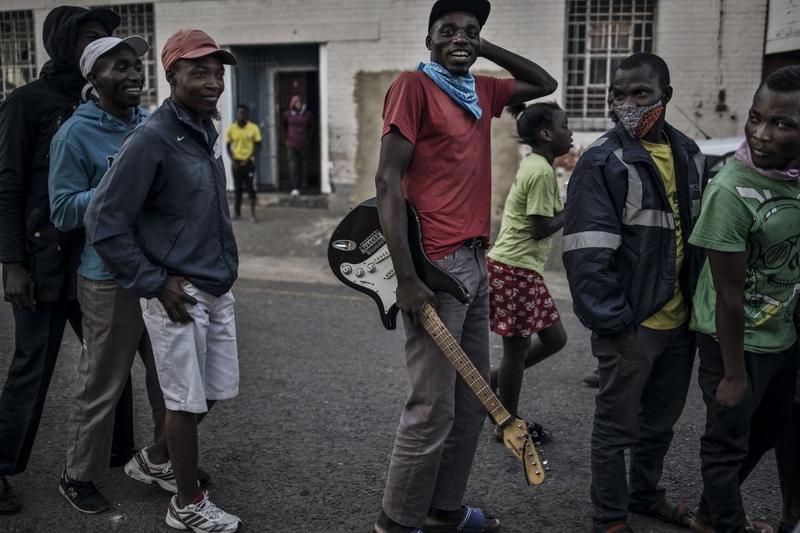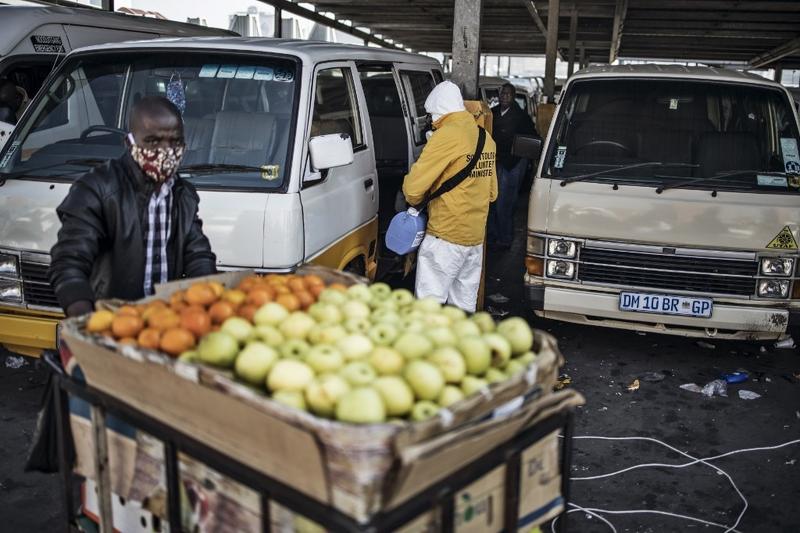 A doctor and laboratory specialists get ready with protective gears before visiting the ward for quarantined people who had close contacts with the first Kenyan patient of the COVID-19 at the Infectious Disease Unit of Kenyatta National Hospital in Nairobi, Kenya, on March 15, 2020. (YASUYOSHI CHIBA / AFP)
A doctor and laboratory specialists get ready with protective gears before visiting the ward for quarantined people who had close contacts with the first Kenyan patient of the COVID-19 at the Infectious Disease Unit of Kenyatta National Hospital in Nairobi, Kenya, on March 15, 2020. (YASUYOSHI CHIBA / AFP)
Even in a best-case scenario, the continent could need at least 10 times the number it has now as the outbreak peaks, an analysis of researchers’ projections showed.
The World Health Organization (WHO) has warned that Africa, home to 1.3 billion people, could become the next epicentre of the pandemic
The shortages across Africa’s national health systems are among the starkest elements to emerge from the survey, which polled 54 countries and received responses from health officials or independent experts in 48 of them. The results provide the most detailed public picture to date of the continent’s key resources, testing and personnel for the disease caused by the new coronavirus, which has killed more than 262,000 people worldwide, according to a Reuters tally.
The World Health Organization (WHO) has warned that Africa, home to 1.3 billion people, could become the next epicentre of the pandemic.
The continent has recorded over 51,000 COVID-19 cases, a fraction of the 3.76 million recorded globally, according to a Reuters tally. But low levels of testing make it impossible to know the true scale of infection. The United Nations Economic Commission for Africa (UNECA) has said Africa could see nearly 123 million cases this year, causing 300,000 deaths.
Assuming a complete lockdown for an indefinite period, at least 121,000 critical care beds will be needed continent-wide when the pandemic peaks, according to a Reuters analysis of the projections by scientists at Britain’s MRC Centre for Global Infectious Disease Analysis at Imperial College London, on which the UNECA forecasts are based.
 A man holds his electric guitar as he lines up at a food distribution in the Kwa Mai Mai area of the Johannesburg CBD, in Johannesburg, on May 6, 2020. (MARCO LONGARI / AFP)
A man holds his electric guitar as he lines up at a food distribution in the Kwa Mai Mai area of the Johannesburg CBD, in Johannesburg, on May 6, 2020. (MARCO LONGARI / AFP)
That compares with just 9,800 available intensive care beds found in the survey, conducted through April and May. The survey also revealed severe shortfalls in testing, personnel and oxygen supplies.
Many African nations moved quickly to contain the virus, launching high-profile public health campaigns, restricting movement and repurposing factories to produce protective equipment.
“We are preparing,” said Dr. Juliet Nyaga, chief executive of Karen Hospital, a private facility in Kenya, as she showed Reuters an isolation unit they had set up in a nursing school. “But it’s like being in a movie that no one has ever rehearsed, and we didn’t get the script.”
International organizations including the WHO and World Bank are helping, but they say they are hampered by problems finding reliable data to measure the continent’s needs.
TESTS
Africa’s testing capacity has expanded sharply but the continent has still carried out only around 685 tests per million people, according to Reuters’ tally of figures from the Africa Centres for Disease Control and Prevention (Africa CDC).
By comparison, Europe has carried out nearly 17 million tests, or just under 23,000 per million.
“If you don’t test, you don’t find,” said John Nkengasong, director of the Africa CDC.
The organization, set up by the African Union in 2017, worked with the WHO to rapidly roll out testing.
In January, only South Africa and Senegal could test; now all African countries can except for tiny Lesotho and the island nation of Sao Tome and Principe.
Yet many cannot make full use of their capacity. Kenya’s labs could carry out 37,000 tests daily, a Senate report based on information from the health ministry found, but it has only done 26,000 to date. It lacks laboratory personnel, sample collection kits and supplies, and has also received faulty test kits as donations, the report said.
Chad and Burundi have carried out fewer than 500 tests each. Mahamout Khayal, Chad’s health minister, told Reuters that testing levels were low due to a lack of kits, but also because many staff who had been carrying out tests had themselves fallen ill, so were no longer able to work.
CRITICAL CARE
The WHO estimates around 14 percent of COVID-19 patients will require hospitalization and oxygen support, and about 5 percent will need a ventilator - generally found in an intensive care unit (ICU).
Even in the best-case scenario, the Reuters survey suggests, an average of 12 COVID-19 patients in Africa could be lined up for each available ICU bed at the height of the outbreak, although the timing of peak demand will differ in each country.
 Steven Smith (center), a Scientology Volunteer Minister, prepares to spray a taxi with disinfectant at the Bree taxi rank in Newtown, Johannesburg, on May 7, 2020 while a fruit vendor walks by. (MARCO LONGARI / AFP)
Steven Smith (center), a Scientology Volunteer Minister, prepares to spray a taxi with disinfectant at the Bree taxi rank in Newtown, Johannesburg, on May 7, 2020 while a fruit vendor walks by. (MARCO LONGARI / AFP)
The continent’s three most populous nations - Nigeria, Ethiopia and Egypt - have 1,920 intensive care beds between them for more than 400 million people. Nigeria’s health minister said the country had not had to use most of its ICU equipment yet, but had still ordered more. The other two nations did not respond to requests for comment.
Most COVID-19 patients who need critical care also need a ventilator. However, Reuters found that just over 9,300 of the continent’s 9,800 intensive care beds have them
Intensive care beds are expensive, difficult to run, and unevenly distributed. Chad, an oil-rich but impoverished nation of 15 million people, has only 10, whereas the island nation of Mauritius, a financial hub home to 1.2 million, has 121.
Most COVID-19 patients who need critical care also need a ventilator. However, Reuters found that just over 9,300 of the continent’s 9,800 intensive care beds have them.
Some nations, such as Guinea Bissau, have no ventilators at all. Mauritania has one; Liberia said it has six; Somalia has 19.
Tumane Balde, head of an inter-ministerial commission to tackle COVID-19 in Guinea-Bissau, said the country only had 10 percent of the equipment it needs. “Our staff are under-equipped and unmotivated,” he said. “We need three times more beds than we have.”
Officials at Mauritania’s health ministry, and a representative for Liberia did not respond to requests for comment.
South Africa has 3,300 ventilators, but about two-thirds are in private hospitals, which most people cannot afford. The health ministry said the state has the right to use private facilities in an emergency.
Ventilators need oxygen, which can come from oxygen plants, cylinders or machines. Kenya has nearly 300 ventilators but a “critical shortage” of oxygen, the Senate report found.
Last month, its ministry of health implored hospitals to pay outstanding bills to the company that supplies many of them with cylinders.
SECRETIVE NATIONS
Information is as important as equipment. Some nations have been quick to provide health data. In others, information is patchy, out of date or secret. Some leaders may fear public criticism over crumbling public services, said Michel Yao, emergency operations manager in Africa for the WHO.
“Information is critical for us to better help,” he told Reuters. “It’s difficult to anticipate their overall needs if you don’t have accurate information.”
The East African nation of Tanzania, publicly criticised by the WHO for not restricting large gatherings, has sometimes gone for days without updating its coronavirus figures.
It won’t tell donors about its public health resources, a diplomat told Reuters. A government spokesman denied allegations Tanzania was not sharing information and referred Reuters to the health ministry, which did not respond.
ALSO READ: Asia eases rules; Africa stays alert
And official figures don’t always match frontline experience.
Uganda said it has 268 ICU beds in public hospitals. But only about 70 ICU beds countrywide have enough staff and equipment to function, said Arthur Kwizera, a lecturer in anaesthesia and intensive care at Makerere University College of Health Sciences, whose team carried out a study on intensive care capacity late last year. The government did not respond to requests for comment on that point.
Many ICU beds are also already in use. Kenya, for example, has 518 beds in its public and private facilities, but 94 percent are already occupied by non-COVID-19 patients, said the Senate report.
POWER AND PEOPLE
In nations such as Nigeria, South Sudan and Zimbabwe, electricity is extremely unreliable
Even where equipment is available, power and personnel may not be. In nations such as Nigeria, South Sudan and Zimbabwe, electricity is extremely unreliable. Hospitals depend on diesel-powered generators, but some can’t afford refueling and maintenance.
Doctors, critical care nurses, anaesthesiologists and biotechnicians - essential for maintaining equipment - are in short supply, data from the World Federation of Societies of Anaesthesiologists (WFSA) and World Bank shows - although figures from many countries date back years.
Continent-wide, one doctor serves an average of 80,000 people, World Bank data shows.
Anaesthetists often run critical care units in Africa. But only nine countries have one or more physician qualified to administer anaesthetics per 100,000 people, according to the WFSA.
READ MORE: Africa’s women, children face more risks
Equipment and personnel are arriving: The World Bank is helping more than 30 African nations obtain more than US$1 billion worth of equipment. And planeloads of aid are arriving from Turkey, China, Europe and the Middle East.
The private sector is also gearing up. Private hospitals are generally better staffed, but their revenues have been squeezed by a decline in elective surgeries and regular outpatient chronic treatment, said the Africa Healthcare Federation, an umbrella organisation for private healthcare.
Some governments on the continent are trying to negotiate access to private hospitals for patients who can’t afford the fees.
But most private hospitals need some form of payment and - mindful of governments that pay bills late or not at all - some want an internationally-administered independent fund to handle the payments.


